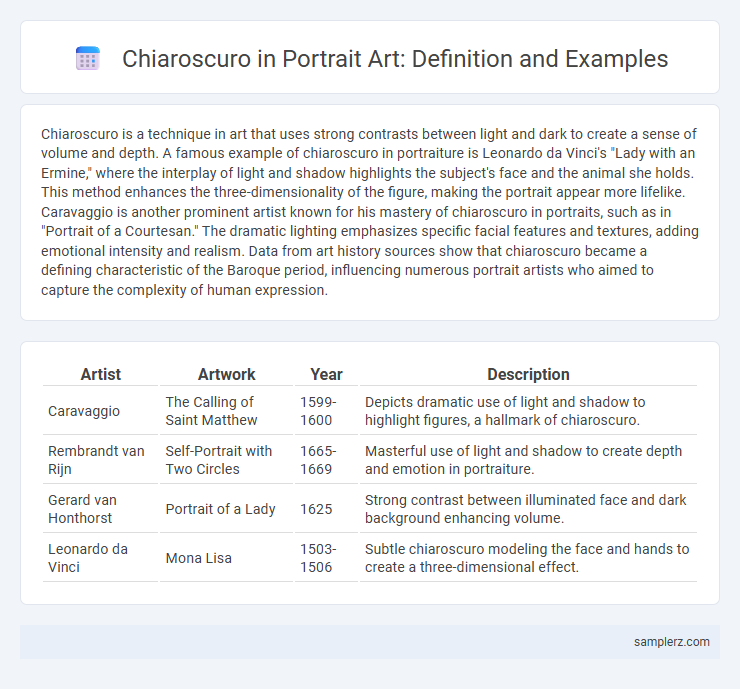Chiaroscuro is a technique in art that uses strong contrasts between light and dark to create a sense of volume and depth. A famous example of chiaroscuro in portraiture is Leonardo da Vinci's "Lady with an Ermine," where the interplay of light and shadow highlights the subject's face and the animal she holds. This method enhances the three-dimensionality of the figure, making the portrait appear more lifelike. Caravaggio is another prominent artist known for his mastery of chiaroscuro in portraits, such as in "Portrait of a Courtesan." The dramatic lighting emphasizes specific facial features and textures, adding emotional intensity and realism. Data from art history sources show that chiaroscuro became a defining characteristic of the Baroque period, influencing numerous portrait artists who aimed to capture the complexity of human expression.
Table of Comparison
| Artist | Artwork | Year | Description |
|---|---|---|---|
| Caravaggio | The Calling of Saint Matthew | 1599-1600 | Depicts dramatic use of light and shadow to highlight figures, a hallmark of chiaroscuro. |
| Rembrandt van Rijn | Self-Portrait with Two Circles | 1665-1669 | Masterful use of light and shadow to create depth and emotion in portraiture. |
| Gerard van Honthorst | Portrait of a Lady | 1625 | Strong contrast between illuminated face and dark background enhancing volume. |
| Leonardo da Vinci | Mona Lisa | 1503-1506 | Subtle chiaroscuro modeling the face and hands to create a three-dimensional effect. |
Defining Chiaroscuro in Portraiture
Chiaroscuro in portraiture is defined by the dramatic interplay of light and shadow to enhance three-dimensionality and emotional depth, exemplified in works like Caravaggio's "Portrait of a Young Man." This technique emphasizes contrasts between illuminated and dark areas, sculpting facial features with intense realism. By manipulating light, chiaroscuro elevates the psychological presence of the subject, making portraits visually compelling and richly textured.
Historical Evolution of Chiaroscuro Technique
Chiaroscuro, a technique characterized by the dramatic contrast between light and shadow, evolved significantly during the Renaissance with artists like Leonardo da Vinci and Caravaggio pioneering its use to enhance three-dimensionality in portraiture. Caravaggio's intense chiaroscuro brought emotional depth and realism, influencing Baroque portrait artists who further experimented with light to evoke mood. The historical evolution of chiaroscuro highlights its transition from subtle tonal gradations in early Renaissance works to bold contrasts that define character and atmosphere in later European art.
Renaissance Masters: Chiaroscuro Portraits
Chiaroscuro portraits by Renaissance masters like Leonardo da Vinci and Caravaggio exemplify the dramatic interplay of light and shadow, enhancing the three-dimensionality and emotional intensity of their subjects. Leonardo's "Mona Lisa" employs subtle gradations of light to create a lifelike presence, while Caravaggio's portrait "The Musicians" uses stark contrasts to heighten realism and depth. These artists revolutionized portrait techniques by manipulating chiaroscuro to capture human expression and form with remarkable realism.
Caravaggio: The Pioneer of Dramatic Lighting
Caravaggio revolutionized portrait painting by mastering chiaroscuro, using stark contrasts between light and shadow to heighten emotional intensity and realism. His work "The Calling of Saint Matthew" exemplifies this technique, where a beam of light dramatically illuminates the central figures against a dark background. This pioneering use of chiaroscuro not only enhanced depth but also directed viewers' focus, influencing generations of Baroque artists.
Rembrandt’s Iconic Use of Light and Shadow
Rembrandt's iconic use of chiaroscuro in portraiture creates dramatic contrasts between light and shadow, emphasizing emotional depth and realism. His masterful manipulation of light highlights facial expressions, drawing viewers into the psychological complexity of his subjects. This technique revolutionized Baroque art, setting a standard for portrait painting that continues to influence artists today.
Modern Portraits Influenced by Chiaroscuro
Modern portraits influenced by chiaroscuro exhibit dramatic contrasts between light and shadow, highlighting facial features with intense depth and emotion. Artists like Chuck Close and Kehinde Wiley utilize chiaroscuro techniques to create striking realism and dynamic compositions in their work. This approach enhances three-dimensionality and adds psychological complexity to contemporary portraiture.
Techniques for Achieving Chiaroscuro in Painting
Chiaroscuro in portrait painting is achieved by manipulating strong contrasts between light and shadow to create depth and volume. Techniques such as gradual shading, layering translucent glazes, and precise brushwork help to model the facial features realistically while enhancing dramatic effect. Master artists like Caravaggio employed these methods to evoke emotional intensity and three-dimensionality in their works.
Chiaroscuro in Contemporary Photography Portraits
Chiaroscuro in contemporary photography portraits emphasizes dramatic contrasts between light and shadow to enhance depth and emotion. Photographers like Steve McCurry utilize this technique to highlight facial features and create a compelling narrative within the frame. The interplay of light and dark elements adds a timeless, three-dimensional quality that draws viewers into the subject's personality.
Emotional Impact of Chiaroscuro in Portraits
Chiaroscuro in portraiture intensifies emotional depth by contrasting light and shadow to highlight facial expressions, revealing inner turmoil or serenity. The dramatic interplay between illumination and darkness captures subtle emotions such as vulnerability, tension, or contemplation, forging a powerful connection with the viewer. Portraits by artists like Rembrandt exemplify how chiaroscuro emphasizes psychological complexity and evokes profound emotional resonance.
Notable Chiaroscuro Portraits and Their Analysis
Notable chiaroscuro portraits include Caravaggio's "The Calling of Saint Matthew," where dramatic contrasts of light and shadow emphasize emotional intensity and narrative depth. Rembrandt van Rijn's self-portraits utilize chiaroscuro to create a profound sense of realism and psychological insight, highlighting the texture of skin and the play of light on facial features. These works exemplify chiaroscuro's capacity to enhance three-dimensionality and convey complex human expressions through controlled lighting techniques.

example of chiaroscuro in portrait Infographic
 samplerz.com
samplerz.com